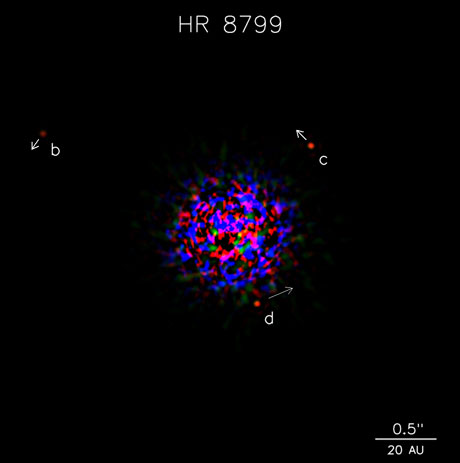In a painstaking re-analysis of Hubble Space Telescope images from 1998, astronomers have found visual evidence for two extrasolar planets that went undetected back then.
Finding these hidden gems in the Hubble archive gives astronomers an invaluable time machine for comparing much earlier planet orbital motion data to more recent observations. It also demonstrates a novel approach for planet hunting in archival Hubble data.
Four giant planets are known to orbit the young, massive star HR 8799, which is 130 light-years away. In 2007 and 2008 the first three planets were discovered in near-infrared ground-based images taken with the W.M. Keck Observatory and the Gemini North telescope by Christian Marois of the National Research Council in Canada and his team. Marois and his colleagues then uncovered the fourth and innermost planet in 2010. This is the only multiple-exoplanet system for which astronomers have obtained direct snapshots.
In 2009 David Lafreniere of the University of Montreal recovered hidden exoplanet data in Hubble images of HR 8799 taken in 1998 with the Near Infrared Camera and Multi-Object Spectrometer (NICMOS). He identified the position of the outermost planet known to orbit the star. This first demonstrated the power of a new data-processing technique for retrieving faint planets buried in the glow of the central star.
A new analysis of the same archival NICMOS data by Remi Soummer of the Space Telescope Science Institute in Baltimore has recovered all three of the outer planets. The fourth, innermost planet is 1.5 billion miles from the star and cannot be seen because it is on the edge of the NICMOS coronagraphic spot that blocks the light from the central star.
By finding the planets in multiple images spaced over years of time, the orbits of the planets can be tracked. Knowing the orbits is critical to understanding the behavior of multiple-planet systems because massive planets can perturb each other's orbits. "From the Hubble images we can determine the shape of their orbits, which brings insight into the system stability, planet masses and eccentricities, and also the inclination of the system," says Soummer.
These results are to be published in the
Astrophysical Journal.
The three outer gas-giant planets have approximately 100-, 200-, and 400-year orbits. This means that astronomers need to wait a very long time to see how the planets move along their paths. The added time span from the Hubble data helps enormously. "The archive got us 10 years of science right now," he says. "Without this data we would have had to wait another decade. It's 10 years of science for free."
Nevertheless, the slowest-moving, outermost planet has barely changed position in 10 years. "But if we go to the next inner planet we see a little bit of an orbit, and the third inner planet we actually see a lot of motion," says Soummer.
The planets weren't found in 1998 when the Hubble observations were first taken because the methods used to detect them were not available at that time. When astronomers subtracted the light from the central star to look for the residual glow of planets, the residual light scatter was still overwhelming the faint planets.
Lafreniere developed a way to improve this type of analysis by using a library of reference stars to more precisely remove the "fingerprint" glow of the central star. Soummer's team took Lafreniere's method a step further and used 466 images of reference stars taken from a library containing over 10 years of NICMOS observations assembled by Glenn Schneider of the University of Arizona.
Soummer's team further increased contrast and minimized residual starlight. They completely removed the diffraction spikes, which are artifacts common to telescope imaging systems. This allowed them to see two of the faint inner planets in the Hubble data. The planets recovered in the NICMOS data are about 1/100,000th the brightness of the parent star when viewed in near-infrared light.
Soummer's team included recent undergraduates. "This work was a formidable opportunity to experience a challenging research project with a professional astronomer right after undergrad," says Brendan Hagan, a recent graduate from Goucher College. "We worked long and hard to achieve this result, and what's really exciting now is that we're going to apply the same method to a bunch of other stars, and hopefully we'll make some discoveries of our own," he adds.
Soummer next plans to analyze approximately 400 other stars in the NICMOS archive with the same technique, improving image quality by a factor of 10 over the imaging methods used when the data were obtained.
He and his team selected the stars from a half dozen surveys. "We wanted to revisit surveys taken of young, nearby stars, as these are prime targets for imaging exoplanets," says Laurent Pueyo, a NASA Sagan Fellow working with Soummer. "Stars with evidence of circumstellar dust will also be good targets, as this is commonly linked with planet formation."
Soummer's work demonstrates the power of the Hubble Space Telescope data archive, which harbors images and spectral information from over 20 years of Hubble observations. Astronomers tap into this library to complement new observations with a wealth of invaluable data already gathered, yielding much more discovery potential than new observations alone.
From the NICMOS archive data Soummer's team will assemble a list of planetary candidates to be confirmed by ground-based telescopes. If new planets are discovered they will once again have several years' worth of orbital motion to measure.





